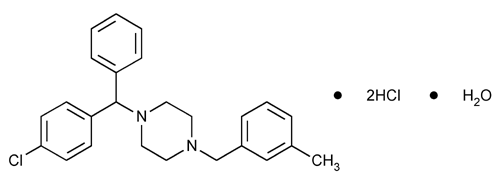Meclizine Hydrochloride
Piperazine, 1-[(4-chlorophenyl)phenylmethyl]-4-[(3-methylphenyl)methyl]-, dihydrochloride, monohydrate.
1-(p-Chloro-
Anhydrous 463.88
» Meclizine Hydrochloride contains not less than 97.0 percent and not more than 100.5 percent of C25H27ClN2·2HCl, calculated on the anhydrous basis.
Packaging and storage—
Preserve in tight containers.
Identification—
Solution:
10 µg per mL.
Medium:
dilute hydrochloric acid (1 in 100).
C:
Dissolve 25 mg in a mixture of 3 mL of 2 N nitric acid and 5 mL of alcohol: the solution meets the requirements of the tests for Chloride  191
191 .
.
Water, Method I  921
921 :
not more than 5.0%.
:
not more than 5.0%.
Residue on ignition  281
281 :
not more than 0.1%.
:
not more than 0.1%.
Change to read:
Chromatographic purity—
Mobile phase—
Dissolve 1.5 g of sodium 1-heptanesulfonate in 300 mL of water, and mix this solution with 700 mL of acetonitrile. Adjust with 0.1 N sulfuric acid to a pH of 4, filter, and degas. Make adjustments if necessary (see System Suitability under Chromatography  621
621 ).
).
Standard solution—
Dissolve an accurately weighed quantity of USP Meclizine Hydrochloride RS in Mobile phase, and dilute quantitatively, and stepwise if necessary, with Mobile phase to obtain a solution having a known concentration of about 2.5 µg per mL.
Test solution—
Prepare a solution of Meclizine Hydrochloride in Mobile phase having a known concentration of about 0.5 mg per mL.
System suitability solution—
Prepare a solution in Mobile phase containing about 0.01 mg of USP Meclizine Hydrochloride RS and 0.01 mg of 4-chlorobenzophenone per mL.
Chromatographic system
(see Chromatography  621
621 )—The liquid chromatograph is equipped with a 230-nm detector and a 4.6-mm × 25-cm column that contains
)—The liquid chromatograph is equipped with a 230-nm detector and a 4.6-mm × 25-cm column that contains  5-µm
5-µm USP32 packing L1. The flow rate is about 1.3 mL per minute. Chromatograph the System suitability solution, and record the peak responses as directed for Procedure:
USP32 packing L1. The flow rate is about 1.3 mL per minute. Chromatograph the System suitability solution, and record the peak responses as directed for Procedure:  the elution order is meclizine, followed by 4-chlorobenzophenone;
the elution order is meclizine, followed by 4-chlorobenzophenone; USP32 and the resolution, R, between the 4-chlorobenzophenone and meclizine hydrochloride peaks is not less than 2.0. Chromatograph the Standard solution, and record the peak responses as directed for Procedure: the tailing factor for the analyte peak is not more than 1.5; the column efficiency, N, determined from the analyte peak is not less than 1800 theoretical plates; and the relative standard deviation for replicate injections is not more than 1.5%.
USP32 and the resolution, R, between the 4-chlorobenzophenone and meclizine hydrochloride peaks is not less than 2.0. Chromatograph the Standard solution, and record the peak responses as directed for Procedure: the tailing factor for the analyte peak is not more than 1.5; the column efficiency, N, determined from the analyte peak is not less than 1800 theoretical plates; and the relative standard deviation for replicate injections is not more than 1.5%.
Procedure—
Separately inject equal volumes (about 20 µL) of the Standard solution and the Test solution into the chromatograph. Allow the Test solution to elute for not less than three times the retention time of meclizine hydrochloride. Record the chromatograms and measure all of the peak areas. Calculate the percentage of each impurity in the portion of Meclizine Hydrochloride taken by the formula: 
 USP32 CS is the concentration, in µg per mL, of meclizine hydrochloride in the Standard solution, and the multiplier of 0.001 is for conversion of µg per mL to mg per mL; CU is the concentration, in mg per mL, of Meclizine Hydrochloride in the Test solution; rU is the peak response for each impurity obtained from the Test solution; and rS is the response of the meclizine peak obtained from the Standard solution: not more than 0.5% of any single impurity is found, and not more than 1.0% of total impurities is found.
USP32 CS is the concentration, in µg per mL, of meclizine hydrochloride in the Standard solution, and the multiplier of 0.001 is for conversion of µg per mL to mg per mL; CU is the concentration, in mg per mL, of Meclizine Hydrochloride in the Test solution; rU is the peak response for each impurity obtained from the Test solution; and rS is the response of the meclizine peak obtained from the Standard solution: not more than 0.5% of any single impurity is found, and not more than 1.0% of total impurities is found.
100(1/F)(0.001CS / CU)(rU / rS)
in which F is the relative response factor, which is equal to 0.72 for the 4-chlorobenzophenone peak and 1.0 for all other peaks;
Assay—
Dissolve about 350 mg of Meclizine Hydrochloride, accurately weighed, in about 50 mL of chloroform. Add 50 mL of glacial acetic acid, 5 mL of acetic anhydride, and 10 mL of mercuric acetate TS, and titrate with 0.1 N perchloric acid VS, determining the endpoint potentiometrically, using a calomel-glass electrode system (see Titrimetry  541
541 ). Perform a blank determination, and make any necessary correction. Each mL of 0.1 N perchloric acid is equivalent to 23.19 mg of C25H27ClN2·2HCl.
). Perform a blank determination, and make any necessary correction. Each mL of 0.1 N perchloric acid is equivalent to 23.19 mg of C25H27ClN2·2HCl.
Auxiliary Information—
Please check for your question in the FAQs before contacting USP.
Chromatographic Column—
| Topic/Question | Contact | Expert Committee |
| Monograph | Elena Gonikberg, Ph.D.
Senior Scientist 1-301-816-8251 |
(MDGRE05) Monograph Development-Gastrointestinal Renal and Endocrine |
| Reference Standards | Lili Wang, Technical Services Scientist 1-301-816-8129 RSTech@usp.org |
USP32–NF27 Page 2858
Pharmacopeial Forum: Volume No. 33(6) Page 1186
Chromatographic columns text is not derived from, and not part of, USP 32 or NF 27.
